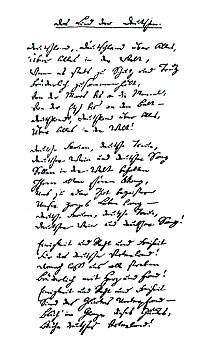Deutschlandlied
| English: The Song of the Germans | |
|---|---|

Facsimile of Hoffmann von Fallersleben's manuscript of "Das Lied der Deutschen"
|
|
|
National anthem of (formerly |
|
| Also known as |
Deutschlandlied English: The Song of Germany |
| Lyrics | August Heinrich Hoffmann von Fallersleben, 1841 |
| Music | Joseph Haydn, 1797 |
| Adopted | 1922 |
| Music sample | |
|
|
|
The "Deutschlandlied" (English: "Song of Germany", German pronunciation: [ˈdɔʏtʃlantˌliːt]; also known as "Das Lied der Deutschen" or "The Song of the Germans"), or part of it, has been the national anthem of Germany since 1922, except in East Germany, whose anthem was "Auferstanden aus Ruinen" ("Risen from Ruins") from 1949 to 1990.
Since World War II and the fall of Nazi Germany, only the third stanza has been used as the national anthem. The stanza's beginning, " und und " ("Unity and Justice and Freedom") is considered the unofficial national motto of Germany, and is inscribed on modern German Army belt buckles and the rims of some German coins.
The music was written by Austrian composer Joseph Haydn in 1797 as an anthem for the birthday of Francis II, Emperor of the Holy Roman Empire and later of Austria, using a tune from a Croat peasant song and on a text beginning with "Gott erhalte Franz, den Kaiser" (God save emperor Franz). In 1841, the German linguist and poet August Heinrich Hoffmann von Fallersleben wrote the lyrics of "Das Lied der Deutschen" as a new text for that music, counterposing the national unification of Germany to the elogy of a monarch, lyrics that were considered revolutionary at the time.
The song is also well known by the beginning and refrain of the first stanza, "Deutschland, Deutschland über alles" ("Germany, Germany above all else"), but this has never been its title. The line "Germany, Germany above all else" meant that the most important goal of 19th-century German liberal revolutionaries should be a unified Germany which would overcome loyalties to the local kingdoms, principalities, duchies, and palatines (Kleinstaaterei) of then-fragmented Germany. Along with the flag of Germany, it was one of the symbols of the March Revolution of 1848.
...
Wikipedia
